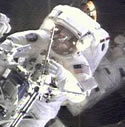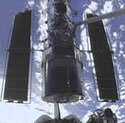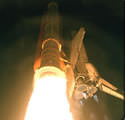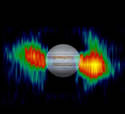
Image credit: JHU
Astronomers from John Hopkins University announced several weeks back that if you averaged out the colour of all stars in the universe, the result would be an aquamarine colour. Well, it turns out they had a bug in their software that mixed the colours together incorrectly. Once they squished the bug, and reran their calculations, the average colour of the entire universe became beige.
What is the color of the Universe? This seemingly simple question has never really been answered by astronomers. It is difficult to take an accurate and complete census of all the light in the Universe.
However using the 2dF Galaxy Redshift Survey – a new survey of more than 200,000 galaxies which measures the light from a large volume of the Universe – we have recently been able to try and answer this question. We have constructed what we call “The Cosmic Spectrum”, which represents all the sum of all the energy in the local volume of the universe emitted at different optical wavelengths of light. This is what the cosmic spectrum looks like:
This is a graph of the energy emitted in the Universe for different wavelengths of light (data here). Ultraviolet and blue light is on the left and red light is on the right. This is constructed by adding together all the individual spectra of the separate galaxies in the 2dF survey. The sum represents the light of all the stars. We believe that because the 2dF survey is so large (reaching out several billion light years) that this spectrum is truly representative. We can also show the cosmic spectrum this way:
Here we have put in the approximate color the eye would see at each wavelength of light (though we cannot really see much light below about 4000 Angstroms, the near ultraviolet; and strictly, monitors cannot accurately display monochromatic colors, the colors of the rainbow).
You can think of this as what the eye would see if we put all the light in the Universe through a prism to produce a rainbow. The intensity of the color is in proportion to it’s intensity in the Universe.
So what is the average color? i.e. the color an observer would see if they had the Universe in a box, and could see all the light at once (and it wasn’t moving, for a real observer on earth, the further away a galaxy from us the more it is redshifted. We have de-redshifted all our light before combining).
To answer this question we must compute the average response of the human eye to these colors. How do we express this color? The most objective way to is quote the CIE x,y values which specify the color’s location in the CIE chromaticity diagram and hence the stimulus the eye would see. Any spectrum with the same x,y must give the same perceived color. These numbers are (0.345,0.345) and they are robust, we have calculated them for different sub-samples of the 2dF survey and they vary insignificantly. We have even computed them for the Sloan Digital Sky Survey spectroscopic survey (which will overtake 2dFGRS as the biggest redshift survey sometime in 2002) and they are essentially the same.
But what is the actual color? Well to do this we have to make some assumptions about human vision and the degree of general illumination. We also need to know what monitor you, the reader, are using! Of course this is impossible, but we can make an average guess. So here are the colors:
What are all these colors? They represent the color of the universe for different white points, which represent the adaptation of the human eye to different kinds of illumination. We will perceive different colors under different circumstances, and the kind of spectrum that appears ‘white’ will vary. A common standard is ‘D65’, which is close to setting daylight (in a slightly overcast sky) as white, and compared to which the universe appears reddish. ‘Illuminant E’ (equal energy white point) is perhaps what you would see for white when dark adapted. ‘Illuminant A’ represents indoor lighting, compared to which the Universe (and daylight) is very blue. We also show the color with and without a gamma correction of 2.2, which is the best thing to do for display on typical monitors. We provide the linear file, so you can apply your own gamma if you wish.
Almost certainly you need to look at the color patches labeled ‘gamma’, but not all displays are the same so your mileage may vary.
So what happened to “turquoise” ?
We found a bug in our code! In our original calculation, which you may have read in the press, we used (in good faith) software with a non-standard white point. Rather it was supposed to use a D65 white point, but did not apply it. The result was an effective white point somewhat redder than Illuminant E (as if some red neon lights were around) at 0.365,0.335. Although the x,y values of the Universe are unchanged from our original calculation the shift in the white point made the universe appear ‘turquoise’. (i.e. x,y, remains the same, but the corresponding effective RGB values shift).
Needless to say since that first calculation we have had a lot of correspondence with color scientists, and have now written our own software to obtain a more accurate color value. We admit the color of the Universe was something of a gimmick, to try and make our story on spectra more accessible. Nevertheless it is an actual calculable thing so we believe it is important to get it right.
We would like to point out that our original intention was merely an amusing footnote in our paper, the original press story blew up beyond our wildest expectations! The mistake took some time to realize and track down. Only a handful of color scientists had the expertise to spot the error. One moral of this story is we should have paid more attention to the ‘color science’ aspect and had that refereed as well.
Enough talk. So what color is the Universe?
Really the answer is so close to white, it is difficult to say. That is why such a small error had such a large effect. The most common choice for white is D65. However if one were to introduce a beam of cosmic spectrum into a room strongly illuminated by light bulbs only (Illuminant A) it would appear very blue, as shown above. Overall, probably Illuminant E is the most correct, for looking at the Universe from afar in dark conditions. So our new best guess is:
BEIGE
Although it’s arguable that it might look more pinkish (like D65 above). Good luck if you can see the difference between this color and white! You should be able to just see it, however if we had made the page background black, it would be very difficult! We have had numerous suggestions for this color emailled to us. We have a top ten, and deem the winner to be “Cosmic Latte” being caffeine biased!
A simulation of the Universe
Because of all these complexities we have decided to see for ourselves. Mark Fairchild at Munsell Color Laboratories in Rochester, NY is working with us to make a simulation of the cosmic spectrum, they can control light sources to give exactly the same red/green/blue eye stimulation as you would see from the cosmic spectrum. We will then be able to view this under a variety of lighting conditions, perhaps simulating deep space, and see for ourselves the true color of the Universe.
The real science story
Of course, our real motive for calculating the cosmic spectrum was really a lot more than producing these pretty color pictures. The color is interesting but in fact the cosmic spectrum is rich in detail and tells us a lot more about the history of star formation in the Universe. You may have noticed above that the cosmic spectrum contains dark lines and bright bands, these correspond to the characteristic emission and absorption of different elements:
These may remind you of Fraunhofer lines in the Solar Spectrum. Exactly the same process of atomic absorption is at work. The strength of the dark lines is determined by the temperatures of the stars contributing to the cosmic spectrum. Older stars have cooler atmospheres and produce a different set of lines to hot young stars. By analyzing the spectrum we can work out the relative proportions of these and try and infer what the star-formation rate was in past ages of the Universe. The gory details of this analysis are given in Baldry, Glazebrook, et al. 2002. A simple picture of our inferred most likely histories of star formation in the Universe is shown here:
All these models give the correct cosmic spectrum in the 2dF survey and all of them say that the majority of stars in the Universe today formed more than 5 billion years ago. This of course implies that the color of the Universe would have been different in the past when there were more hot young blue stars. In fact we can calculate what this would be from our best fitting model. The evolution of the color from 13 billion years ago to 7 billion years in the future looks like this under our various assumptions:
The universe started out young and blue, and grew gradually redder as the population of evolved ‘red’ giant stars built up. The rate of formation of new stars has declined precipitously in the last 6 billion years due to the decline in reserves of interstellar gas for forming new stars. As the star-formation rate continues to decline and more stars become red giants the color of the Universe will become redder and redder. Eventually all stars will disappear and nothing will be left but black holes. These too will eventually evaporate via the Hawking process and nothing will be left except for old light, which will itself redden as the Universe expands forever (in the current cosmological model).
Original Source: JHU News Release






